In order to better understand the historical and social significance of the Soviet Military Cemetery to both Poland and Russia, and why it is now a source of controversy, contained herein is a brief history of Polish-Russian relations starting from World War Two.
In September 1939, Poland was invaded twice, first by Germany on September 1 and then by the Soviet Union on September 17. The Soviets invaded pursuant to the Molotov-Ribbentrop Pact of August 23, 1939. The German invasion triggered the start of World War Two.
Below: New York Times. “Germany Attacks Poland”. World War Two had begun. (source: Bing.com)

Below: German soldiers opening a Polish border crossing. The German invasion of Poland marked the start of World War Two. (source: Bing.com)

In response to the German invasion, France and Great Britain declared war on Germany on September 3, 1939.
Below (top): The Courier-Mail. “Britain Declare War Against Germany Over Poland” France also declared war. Below (bottom): New York Times. “Soviet Troops Marched Into Poland At 11 P.M.” (source: Bing.com)

Below: Battle of Poland, 1939. Poland was invaded from the east, west, north and south. Its fate was quickly sealed. France and Great Britain declared war against Germany but provided no material assistance. (source: Bing.com)

After about five weeks of intense fighting, Polish military forces surrendered. Germany and the Soviet Union divided Poland into three parts: the north and western areas became parts of the Reich; the central and southern areas became the so-called General Government under Nazi domination; and the eastern half of the country became the Soviet zone of occupation (most of which was later formally annexed by the Soviet Union and today is still part of Russia). Poland was wiped off the map.
Below: New York Times, September 19, 1939. “Soviet and Reich Forces Meet, Map Polish Partition.” Poland ceased to exist. (source: Bing.com)

Below: Partition of Poland, 1939. (source: Bing.com)

Below: German and Soviet officers shaking hands, ca. September 1939. Two years later they would enemies. (source: Bing.com)
Defeated and occupied, the Polish population was defenseless. Both occupying powers, each one a totalitarian state, treated the Poles with unrestrained brutality.
The first mass killings in Poland were not of the Jews but of the Polish intellectuals. In the German controlled areas, teachers, civil servants, and academics were shipped to Dachau, Buchenwald or Sachsenhausen, and thousands were shot.
Below: people shipped to concentration camps. All are wearing a red triangle. That was the symbol for “political enemy” (non- Jewish). (source: Bing.com)
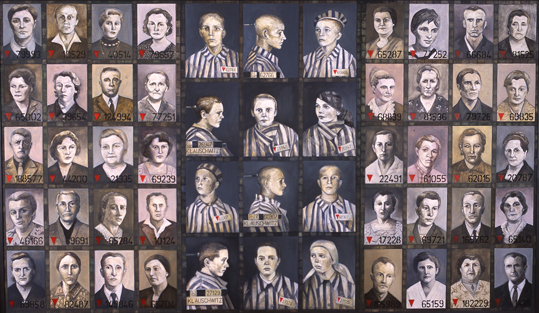
In the Soviet sector the NKVD quickly acted to purge all “undesirables,” (that is, anyone suspected of being anti-communist) from Poland. One and a half million Poles were shipped to gulags inside the Soviet Union. Many died from exhaustion, hypothermia or malnutrition.
Soviet authorities also targeted the Polish military leadership for destruction. In the spring of 1940, in an operation that today is known as the Katyn Massacre, Soviet authorities killed 4,253 Polish officers. The Institute of National Remberance of Poland put the total number murdered at Katyn Forest and at other locations at 21,768.
Below: bodies allegedly exhumed at Katyn, ca. 1943. Man bending over is wearing a Red Cross insignia on his arm. (source: Bing.com)
Below: map showing locations where massacres occurred. (source: Bing.com)
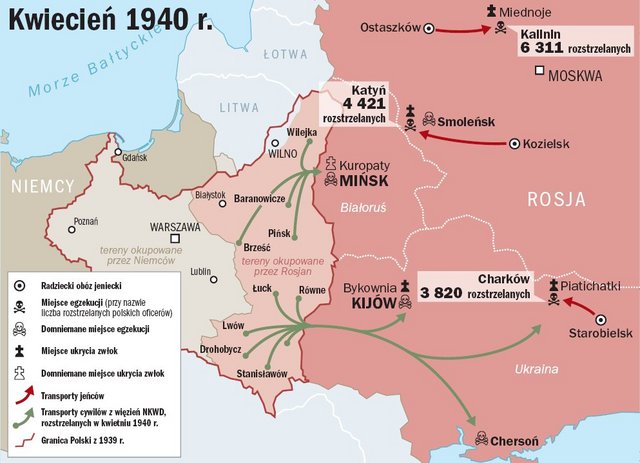
In an ironic twist of history, the Katyn graves were discovered by the Germans in the spring of 1943. Of the bodies later exhumed, 2,914 were positively identified. They included three generals, one rear admiral, 100 colonels and lieutenant-colonels, 300 majors, 1,000 captains, 2,500 first and second lieutenants, and more than 500 officer cadets. All the victims were shot in the back of the head. Some of the bodies shown signs of bayonet wounds to the back and stomach, or their jaws smashed by blows, presumably from the butts of rifles. About fifty percent of the group were reserve officers, who included among their number 21 university professors and lecturers, 300 surgeons and physicians, 200 lawyers, and 300 engineers, as well as teachers, journalists, writers, and industrialists.
The Soviet Union adamantly refused to accept responsibility for the massacre. In a letter to President Roosevelt dated April 23, 1943, Stalin labeled the investigations of the incident a sham and a farce meant to discredit the Soviet Union. Stalin also accused the Polish government in exile of colluding with Hitler. Soviet denials of culpability were false. In April 1990, forty-seven years later, the Soviet Union admitted that the NKVD committed the murders. In 1993, two years after the collapse of Soviet Union, Russian president Boris Yeltsin traveled to Warsaw where he publicly paid homage to the victims.
Below: Memorial to the Katyn Forest Massacre (source: Bing.com)
Below: Russian President Boris Yeltsin placing a wreath at the Memorial to the Katyn Forest Massacre. (source: Bing.com)

In July 1944 the Red Army reached the Vistula River. Soviet units established a bridgehead about 50 miles south of Warsaw. The Soviets also urged the Poles to revolt against the Germans. Radio Moscow broadcasted this message: “For Warsaw, which did not yield but fought on, the hour of action has arrived.” On August 1 the uprising by the Polish Home Army begun. In the ensuing 63-day battle the Germans killed 200,000 Poles and systematically demolished what was left of Warsaw. While Warsaw was being crushed, the Russians remained on the east bank of the Vistula. Appeals to Stalin from both President Roosevelt and Prime Minister Winston Churchill to help the Poles went unheeded. Stalin also refused landing rights to Allied planes to fly in supplies.
The uprising officially ended on October 2. The Germans retaliated against the Poles with unmitigated brutality. Over a half a million Poles were shipped to concentration camps and about 150,000 sent to forced labor camps inside the Reich. The Soviet delay in crossing the Vistula was blamed on the Poles for not coordinating their initiative with operational planning in Eastern Europe.
In January 1945 the Red Army resumed its offensive. It quickly swept through Poland, forcing the Germans to withdraw. Soviet troops liberated Auschwitz.
Below: Soviet soldiers with liberated prisoners at Birkenau, 1945 (source: Bing.com)
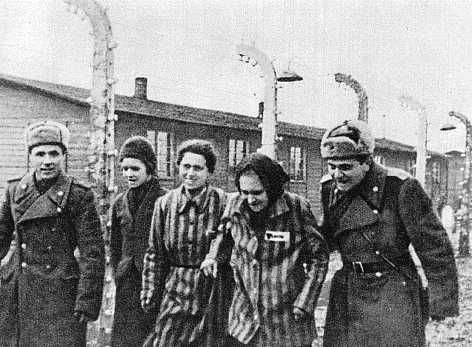

Below: Soviet medical staff assisting newly liberated prisoners at Auschwitz. Note the sign at the top: “Arbeit Macht Frei” (Work makes you free). (source: Bing.com)
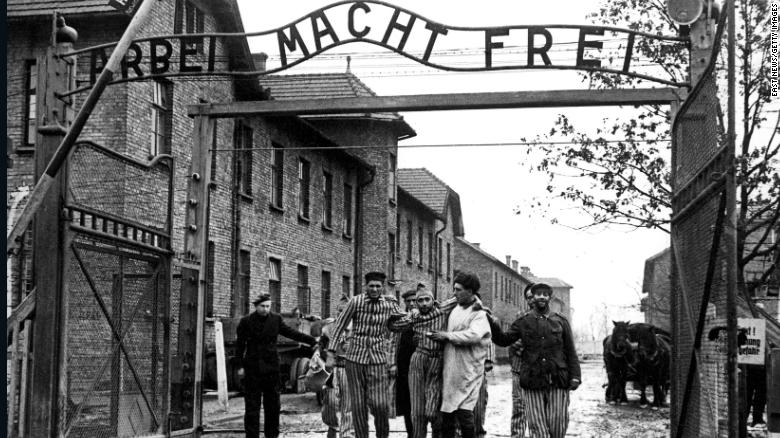
By the end of January practically all remaining German forces were driven from Poland. When the Red Army entered Warsaw, not a single person was still living in the city. The entire place was rubble.
Below: Warsaw after the war. (source: Bing.com)

Below: people welcoming Red Army soldiers (location unknown), ca. 1945. (source: Bing.com)

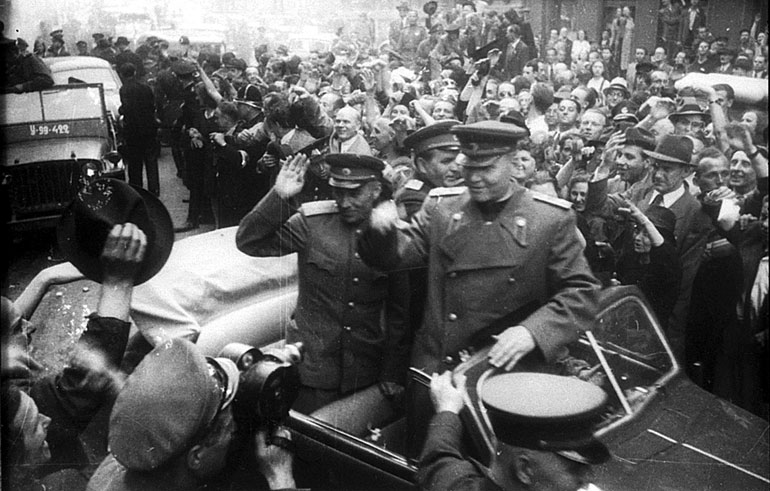

Below: The Soviet liberation of Poland in 1945 was major news in the United States. (source: Bing.com)
All of Poland was now under Soviet control. At the Yalta Conference, February 4 to 11, 1945, Joseph Stalin promised free elections in Poland. Five months later at the Potsdam Conference, July 1945, free elections for Poland were again promised. Those promises was not kept.
Below: Winston Churchill, Franklin D. Roosevelt and Joseph Stalin meet at Yalta, February 1945. At Yalta the status of post-war Poland was discussed.(source: Bing.com)

Instead, Poland became a satellite state of the Soviet Union. In 1956 Polish workers in Poznan rebelled against the communist regime. The Polish army and internal security forces, under the command of Deputy Minister of Defense Stanislaw Poplawski, crushed the revolt. At the same time Soviet premier Nikita Khrushchev ordered preparations be made to launch a full-scale military invasion of Poland. The communist authorities blamed the rebellion on American and West German provocateurs. Khrushchev said, “We shed our blood for this country and now they want to sell it to the Americans.”
Below: Map of Europe during the Cold War. Poland is part of the so-called Warsaw Pact. (source: Bing.com)
In August 1980 the Solidarity movement began. Soon Solidarity expanded into a national crusade which directly challenged the authority of the communist-controlled government.
Below: Solidarity. The demonstrators are demanding freedom (Wolnosc). (source: Bing.com)

In December 1981, the communist government, under the control of General Wojciech Jaruzelski, imposed martial law. However, the Solidarity movement survived. Free elections were finally held in June 1989, forty-four years after elections had been promised at Yalta and Potsdam. Solidarity won the election in a landslide. The communists’ grip on power was shattered. Tadeusz Mazowiecki became premier of Poland’s first non-communist government since World War Two. Poland was finally free.
Lech Walesa, founder of Solidarity and Poland’s first non-communist President since World War Two with U. S. President George H. W. Bush. At left is Barbara Bush. (source: Bing.com)


